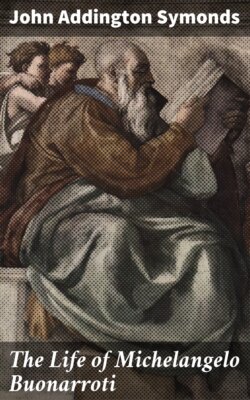Читать книгу The Life of Michelangelo Buonarroti - John Addington Symonds - Страница 20
На сайте Литреса книга снята с продажи.
VIII
ОглавлениеIt may not be inappropriate to discuss the question of the Bruges Madonna here. This is a marble statue, well placed in a chapel of Notre Dame, relieved against a black marble niche, with excellent illumination from the side. The style is undoubtedly Michelangelesque, the execution careful, the surface-finish exquisite, and the type of the Madonna extremely similar to that of the Pietà at S. Peter's. She is seated in an attitude of almost haughty dignity, with the left foot raised upon a block of stone. The expression of her features is marked by something of sternness, which seems inherent in the model. Between her knees stands, half reclining, half as though wishing to step downwards from the throne, her infant Son. One arm rests upon his mother's knee; the right hand is thrown round to clasp her left. This attitude gives grace of rhythm to the lines of his nude body. True to the realism which controlled Michelangelo at the commencement of his art career, the head of Christ, who is but a child, slightly overloads his slender figure. Physically he resembles the Infant Christ of our National Gallery picture, but has more of charm and sweetness. All these indications point to a genuine product of Michelangelo's first Roman manner; and the position of the statue in a chapel ornamented by the Bruges family of Mouscron renders the attribution almost certain. However, we have only two authentic records of the work among the documents at our disposal. Condivi, describing the period of Michelangelo's residence in Florence (1501–1504), says: "He also cast in bronze a Madonna with the Infant Christ, which certain Flemish merchants of the house of Mouscron, a most noble family in their own land, bought for two hundred ducats, and sent to Flanders." A letter addressed under date August 4, 1506, by Giovanni Balducci in Rome to Michelangelo at Florence, proves that some statue which was destined for Flanders remained among the sculptor's property at Florence. Balducci uses the feminine gender in writing about this work, which justifies us in thinking that it may have been a Madonna. He says that he has found a trustworthy agent to convey it to Viareggio, and to ship it thence to Bruges, where it will be delivered into the hands of the heir of John and Alexander Mouscron and Co., "as being their property." This statue, in all probability, is the "Madonna in marble" about which Michelangelo wrote to his father from Rome on the 31st of January 1507, and which he begged his father to keep hidden in their dwelling. It is difficult to reconcile Condivi's statement with Balducci's letter. The former says that the Madonna bought by the Mouscron family was cast in bronze at Florence. The Madonna in the Mouscron Chapel at Notre Dame is a marble. I think we may assume that the Bruges Madonna is the piece which Michelangelo executed for the Mouscron brothers, and that Condivi was wrong in believing it to have been cast in bronze. That the statue was sent some time after the order had been given, appears from the fact that Balducci consigned it to the heir of John and Alexander, "as being their property;" but it cannot be certain at what exact date it was begun and finished.
